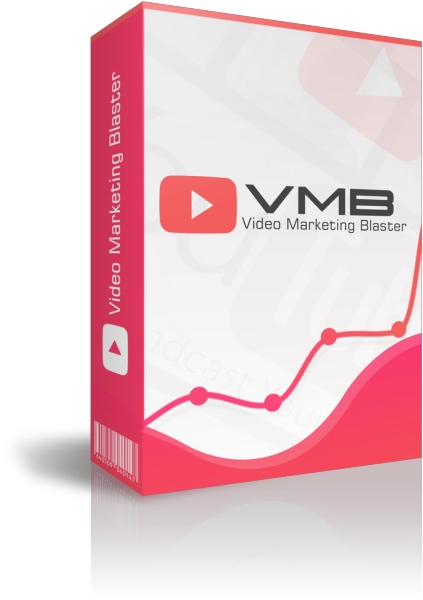Top 10 SEO Ranking Factors for Achieving Page 1 Rankings: Detailed Action Steps

Mastering the important SEO ranking factors is crucial for achieving page 1 rankings on search engines.
These factors help search engines determine the relevance, usability, and authority of your website, directly influencing your visibility and organic search traffic.
Here’s a detailed guide on how to implement each of these top 10 ranking factors to enhance your website’s visibility and performance.
SEO Ranking Factors:
1. High-Quality Content
Content remains king in the realm of SEO. High-quality, engaging, and original content that provides real value to users is crucial. Content should meet the search intent of users, providing accurate answers and comprehensive information on the topics queried.
Longer content with more depth typically performs better in SERPs as it tends to be more comprehensive.
Creating high-quality content is paramount. Follow these steps:
- Identify User Intent: Use tools like Answer the Public to understand what your audience is searching for related to your topic.
- Create Detailed Content: Cover your topic comprehensively. Longer, in-depth articles often perform better in search rankings.
- Use Multimedia: Incorporate images, videos, and infographics to make your content more engaging and easier to understand.
Related Article: AI Powered Content Creation to Revolutionize Marketing (opens in new tab)
2. Mobile-Friendliness
With the majority of global web traffic coming from mobile devices, having a mobile-friendly website is more crucial than ever. Google’s mobile-first indexing prioritizes the mobile version of a website for indexing and ranking.
Ensure your site is responsive, meaning it adjusts smoothly to different screen sizes and resolutions.

To make your website mobile-friendly:
- Responsive Design: Ensure your website automatically adjusts to fit the screen size of devices. Tools like Google’s Mobile-Friendly Test can help check your site’s mobile responsiveness.
- Minimize Loading Time: Optimize images and use mobile-friendly themes to speed up loading times on mobile devices.
3. Page Speed
Page speed is a critical factor for both user experience and SEO. Faster pages are more efficient for users and decrease the bounce rate.
Google’s Core Web Vitals update makes page speed a direct SEO ranking factor, emphasizing metrics like Largest Contentful Paint (LCP), First Input Delay (FID), and Cumulative Layout Shift (CLS).
Improving page speed can significantly enhance user experience and SEO:
- Optimize Images: Use tools like TinyPNG to reduce image file sizes without losing quality.
- Leverage Browser Caching: Implement caching to help return visitors load your website faster.
- Minify CSS and JavaScript: Tools like CSSMinifier can reduce the size of your code files.
You can track Page Speed and other website metrics by installing Google’s own Site Kit Plugin.
Below is the image showing how to install the plugin on your website from admin area:
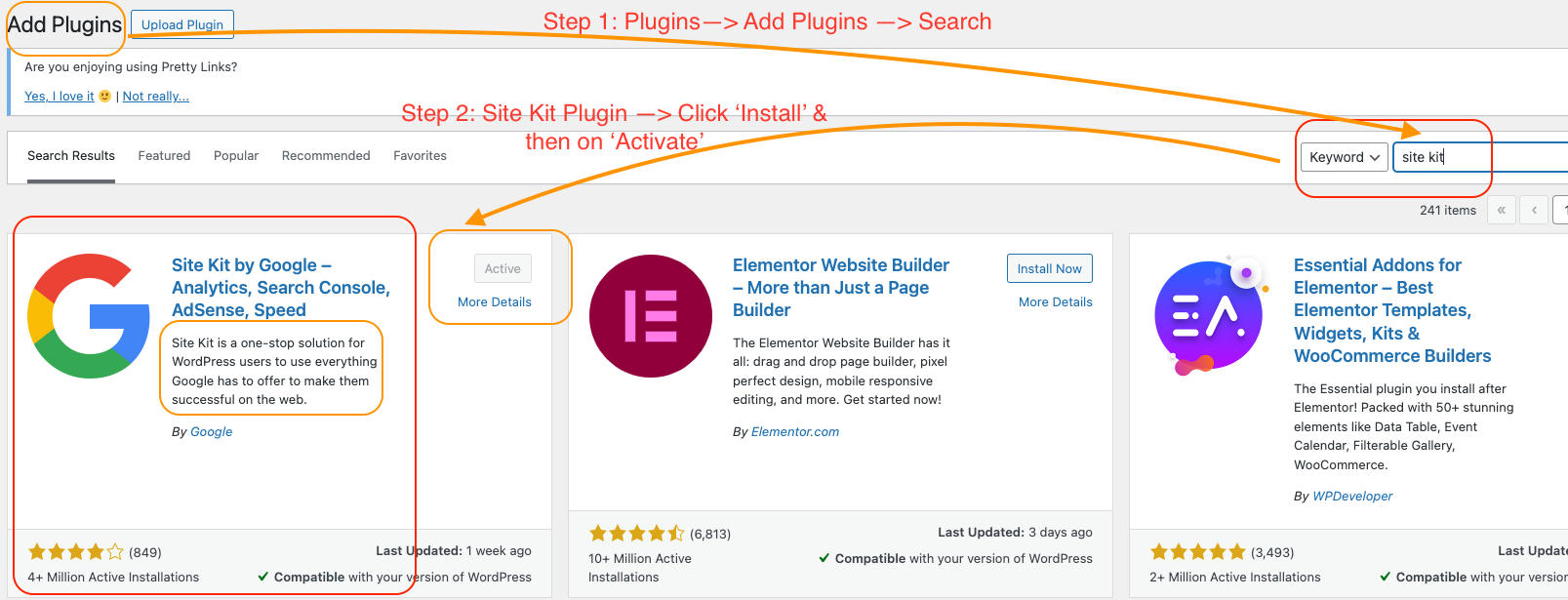
After installing and activating the Google Site Kit Plugin, it’s dashboard and settings pages look like in the below images respectively as of writing this article:
Google Site Kit Dashboard:
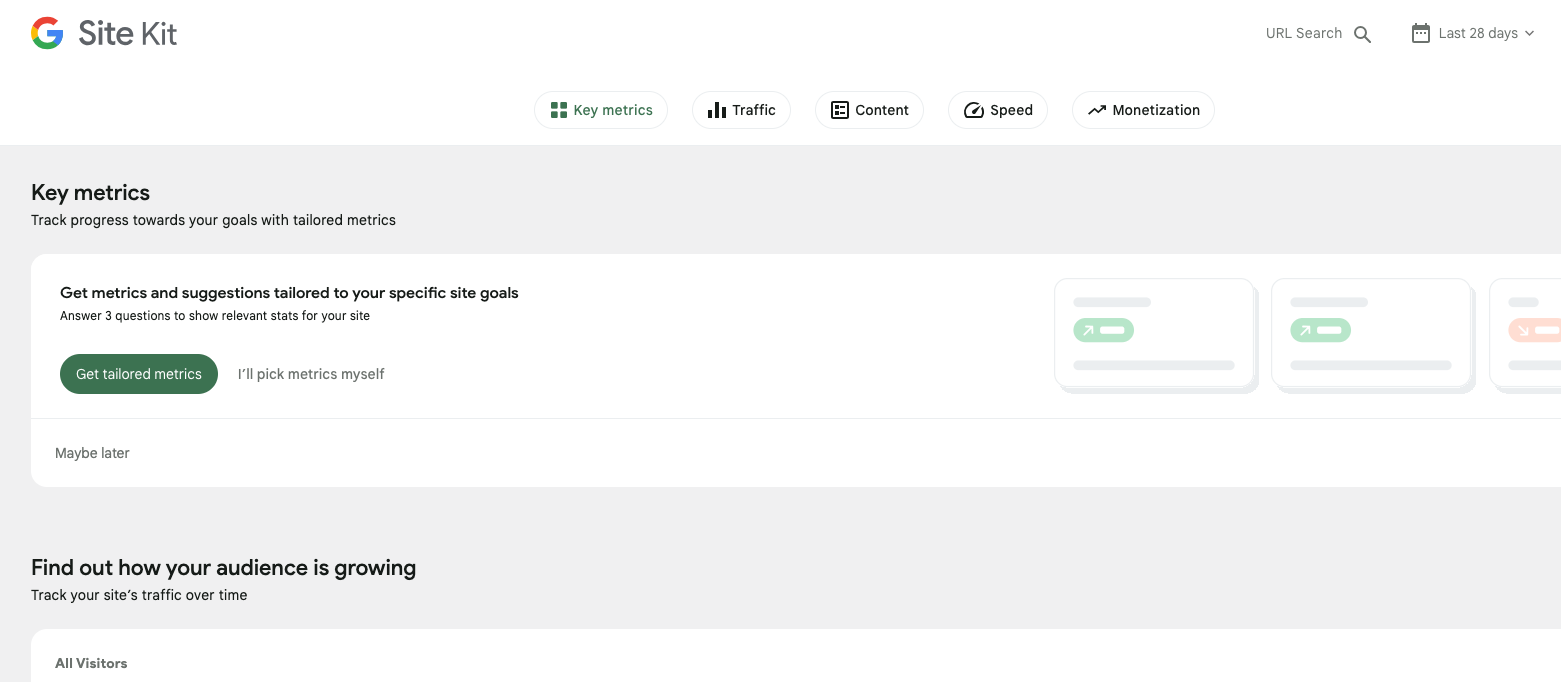
Google Site Kit Settings:
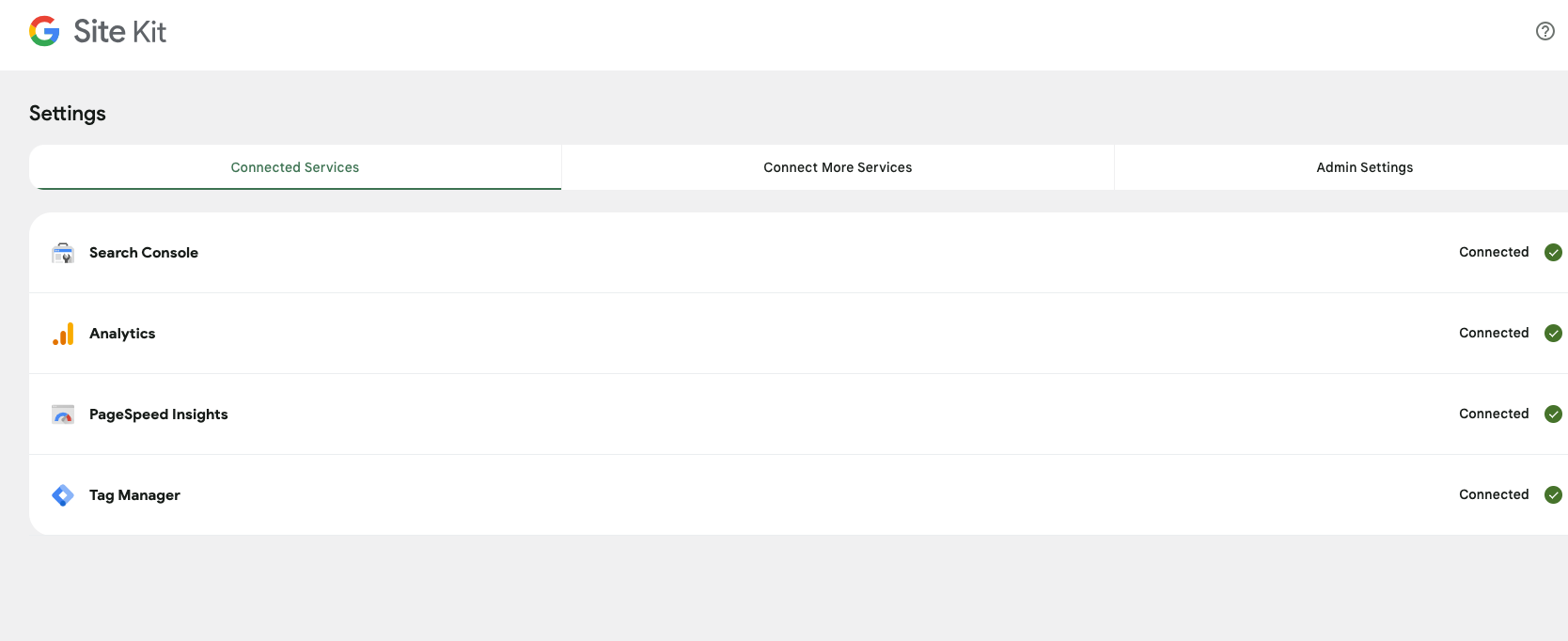
Below is a helpful video tutorial that I found on how to install and use “Site Kit by Google” plugin on your wordpress website
Video Courtesy: The Social Guide YouTube Channel
4. Secure and Accessible Website
Having a secure website (HTTPS vs. HTTP) is a known ranking signal. Additionally, your website must be easy for search engines to crawl. This means having a proper Robots.txt file and a sitemap that lists all your pages.
Make sure your site is secure and easily accessible:
- Switch to HTTPS: Obtain an SSL certificate to secure your website. Most hosting providers offer this as a standard feature without any extra cost.
- Create a Sitemap: Use XML-Sitemaps.com to generate a sitemap and submit it to search engines via their respective webmaster tools.
5. Technical SEO
Technical SEO is one of the most important SEO ranking factors when it comes to ranking your content on search engines!
Proper technical SEO ensures that your site can be easily crawled and indexed. This includes structured data markup, which helps search engines understand content on your website and provides rich snippets in search results.
Additionally, canonical tags, meta tags, and proper use of HTTP headers play significant roles.
Sharpen your technical SEO with the following:
- Structured Data: Implement schema markup to help search engines understand and display your content better. Google’s Structured Data Testing Tool can validate your schema implementation.
- Fix Broken Links: Use tools like Broken Link Check to find and fix dead links on your site.
6. User Engagement
Metrics such as time on site, pages per session, and bounce rate indicate user engagement. Highly engaging sites can achieve better rankings and even page 1 rankings as they suggest the content is valuable and meets user needs.
Enhancing the user experience with interactive elements and intuitive navigation can improve these metrics.
Boosting user engagement can lead to better rankings:
- Improve UI/UX: Ensure your website is easy to navigate and aesthetically pleasing.
- Interactive Content: Include quizzes, polls, or interactive videos to keep users engaged longer.
7. Links
- Link building within SEO is a critical practice that involves more than just acquiring external links.
- It includes the strategic use of internal links and the management of inbound and outbound backlinks.
- Each plays a unique role in enhancing site navigation, spreading page authority, and improving rankings.
7.1 Internal Links
Below is an image showing an internal link in this post:

Internal links are hyperlinks that point from one page to another within the same domain. They are crucial for SEO for several reasons:
- Navigation: They guide users through your website, improving the user experience.
- Authority Distribution: They help spread link equity (ranking power) around websites.
- Site Architecture: They help search engines crawl the site more effectively.
Action Steps for Internal Linking:
- Use Descriptive Anchor Text: Make sure the anchor text is relevant to the target page. This not only helps with SEO but also aids user navigation.
- Link Deep: Beyond linking to your homepage or contact page, focus on linking to deep internal pages on your site.
- Use a Reasonable Number of Internal Links: Don’t overload a single page with too many links. Keep it natural and beneficial to the user.
- Update and Audit Regularly: Periodically check your site for broken links and opportunities to add new internal links, especially to new content.
Tools like Screaming Frog SEO Spider can help identify and manage internal links effectively by analyzing your website’s structure. Also, you can Read this detailed guide on internal linking for SEO (Opens in a new browser tab) to learn more.
7.2 Backlinks (Inbound and Outbound)
Backlinks, or inbound links, are links from other websites that point to your site. They are among the top SEO ranking factors considered by search engines because they are a vote of confidence from one site to another.
Outbound links are links from your website to other websites. They are crucial for providing your audience with additional value and can help establish credibility.
Action Steps for Managing Backlinks:
- Inbound Links (Backlinks):
- Create Link-Worthy Content: Publish high-quality, authoritative, and informative content that others want to link to.
- Guest Blogging: Write articles for other blogs in your industry to earn backlinks.
- Broken Link Building: Use tools like Ahrefs to find broken links on other sites and offer your content as a replacement.
- Outbound Links:
- Link to Relevant and Reputable Sites: Ensure the sites you link to are credible and relevant to your content.
- Use No-Follow Where Appropriate: For paid links or links to less trusted content, use the no-follow attribute to tell search engines not to pass on link equity.
Below is an image of an outbound link in this post:
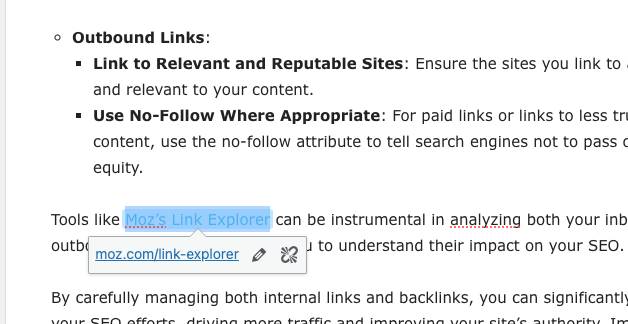
Tools like Moz’s Link Explorer can be instrumental in analyzing both your inbound and outbound link profiles, helping you to understand their impact on your SEO.
By carefully managing both internal links and backlinks, you can significantly enhance your SEO efforts, driving more traffic and improving your site’s authority. Implementing these strategies requires ongoing attention and adjustment, but the payoff can be substantial in boosting your site’s visibility and search engine ranking.
8. Social Signals
While not a direct ranking factor, social signals such as likes, shares, and visibility on social media can enhance SEO indirectly. They increase online visibility and traffic to your content, which can lead to more natural links and higher engagement.
Although not a direct SEO ranking factor, social signals can amplify your SEO efforts:
- Be Active on Social Media: Regularly post content on social media platforms where your audience is active.
- Encourage Sharing: Include social sharing buttons on your content to make it easy for users to share.
Having said that, if you’re finding this post helpful in any way, please share this post on just one of the social media websites by tapping on the FB or X, etc. buttons that appear below on your screen (mobile) or side of the screen (other devices) 🙂
9. Keyword Optimization
Proper keyword optimization is essential for effective on-page SEO. This includes using relevant keywords naturally in your title tags, meta descriptions, headers, and throughout your content.
Below Image Shows keyword optimisation in SEO Title, Post URL Slug, Heading, and post’s content:
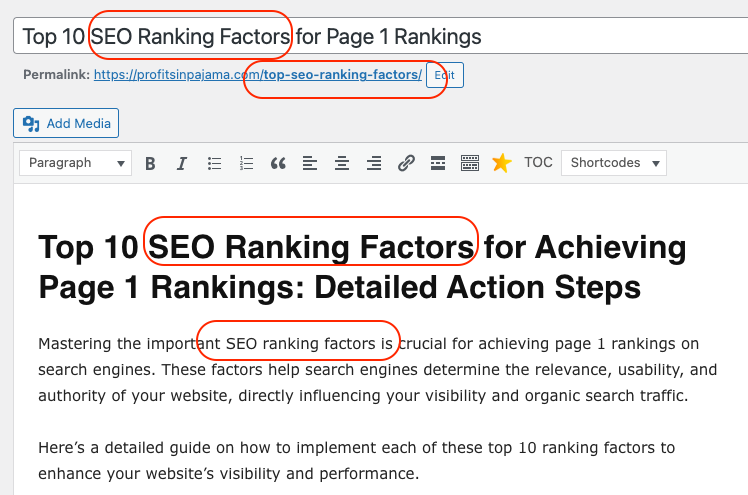
However, avoid keyword stuffing as it can negatively impact your SEO efforts.
Effective keyword optimization involves:
- Keyword Research: Use Google Keyword Planner to find relevant keywords with good search volume.
- Naturally Integrate Keywords: Include keywords in your content naturally, especially in titles, headings, and throughout the body.
Below image shows keyword optimization in slug and meta-description:

You can use Yoast SEO plugin or Rank Math SEO plugin on your website for strategic guidance on each post and page. Above image shows the same provided by Yoast SEO plugin on my website for this post
10. Local SEO
For businesses with a physical location or local presence, local SEO is crucial to rank on page 1 of SERPs. This includes optimizing your Google My Business listing and ensuring your name, address, and phone number (NAP) are consistent across the web.
Local backlinks and local community engagement also strengthen local SEO efforts.
For local businesses, local SEO is crucial:
- Google My Business: Claim and optimize your Google My Business listing.
- Local Keywords: Use location-specific keywords in your content.
- Encourage Reviews: Ask satisfied customers to leave positive reviews on your Google My Business profile.
Dominating SEO Ranking Factors for Page 1 Rankings
By systematically implementing the steps provided above in this article, you can enhance your website’s SEO performance and increase your chances of achieving page 1 rankings on multiple search engines.
Each of these elements not only helps satisfy the technical requirements of search engines but also improves the overall user experience.
This makes your site a better resource for visitors, who will prefer reading other posts on your website. Which means the visitor spends more time on your site & more pages per user session & social shares if the content is in depth and helpful.
All of which signals the search engines of good user experience and user engagement on your website, which improves your SERPs drastically and eventually brings you page 1 rankings!
Frequently Asked Questions:
1. What are the most important SEO ranking factors?
The most important SEO ranking factors include high-quality content, backlinks, page experience, mobile-friendliness, and page speed. High-quality content ensures your site provides valuable information. Backlinks from reputable sites improve your site’s authority. Page experience factors like Core Web Vitals impact how users interact with your site. Mobile-friendliness is crucial due to mobile-first indexing. Page speed affects user experience and bounce rates. Learn more about SEO ranking factors
2. How does content quality affect SEO ranking?
Content quality is a top ranking factor. Google prioritizes content that is original, informative, and valuable to users. High-quality content should cover topics in-depth, use relevant keywords naturally, and be free of grammatical errors. Ensuring your content is engaging and regularly updated can help improve your SEO ranking. Discover how content quality impacts SEO
3. Why are backlinks important for SEO?
Backlinks, or inbound links, are crucial because they signal to search engines that other websites vouch for your content. High-quality backlinks from reputable sites can significantly boost your site’s authority and ranking. However, it’s important to focus on quality over quantity to avoid penalties. Read about the importance of backlinks
4. What is the role of mobile-friendliness in SEO?
Mobile-friendliness is a critical ranking factor due to Google’s mobile-first indexing. This means Google predominantly uses the mobile version of the content for indexing and ranking. A mobile-friendly site improves user experience, reduces bounce rates, and is essential for better search rankings. Learn why mobile-friendliness matters
5. How does page speed influence SEO rankings?
Page speed is an important ranking factor because it affects user experience. Faster loading times reduce bounce rates and improve user engagement. Google uses tools like PageSpeed Insights to measure page speed and considers it when ranking websites. Optimizing images, enabling browser caching, and minimizing JavaScript can help improve your page speed. Improve your page speed for better SEO
6. What are Core Web Vitals and why are they important?
Core Web Vitals are a set of metrics that Google uses to measure user experience. They include Largest Contentful Paint (LCP), First Input Delay (FID), and Cumulative Layout Shift (CLS). These metrics assess loading performance, interactivity, and visual stability of your site. Optimizing these factors is essential for enhancing user experience and improving SEO rankings. Understand Core Web Vitals
7. How does the use of keywords affect SEO?
Keywords are vital for SEO as they help search engines understand the content of your pages. Effective keyword use involves placing keywords in the title, meta descriptions, headers, and throughout the content naturally. Avoid keyword stuffing, as it can lead to penalties. Researching and targeting the right keywords can improve your search visibility. Learn how to use keywords effectively
8. Why is user experience (UX) important for SEO?
User experience (UX) is important because it directly impacts how users interact with your site. Factors like easy navigation, quick load times, mobile compatibility, and engaging content contribute to a positive UX. Google considers UX as a ranking factor because a good UX indicates a high-quality site that meets user needs. Enhance UX for better SEO




